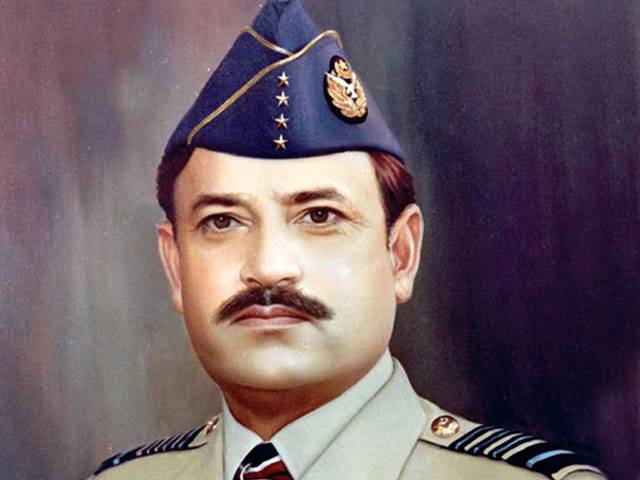LAHORE – Born on October 1, 1931 in Haripur Hazara, Muhammad Anwar Shamim was a natural fighter-pilot and a born leader. He was made to fly and for him even sky was not the limit.
Only a few people on the national scene could be rated as dynamic and as magnetic as Air Chief Marshal Anwar Shamim.
He could easily be declared as the most influential Air Chief in the post 1971 war era till date. One can go on and on counting his contributions for the country in general and Pakistan Air Force in particular.
His tenure of command in the PAF spanned over seven years, the second only to Air Marshal Asghar Khan.
His tenure would always be remembered for transforming the PAF into a truly dynamic and responsive service, which played a significant role in defeating a superpower of its time; the Soviet Union during the first Afghan War in the early 1980s.
Shamim was the product of the time when Pakistan was shaping upto become an important country of the United States-led regional alliances to counter the spread of communism led by the Soviet Union.
He was trained at the Point Cook, Royal Australian Air Force (RAAF) in his early years of the flying training.
He earned his Commission in the Royal Pakistan Air Force (RPAF) on 14 March 1952. During his service carrier spanned over 33 years, Shamim served on all important Command and Staff appointments, including the command of three bases; Masroor, Korangi Creek and Sakesar, an all important 31 Fighter Wing and No 11 Squadron. He participated in 1965 and 1971 wars with flying colours and was decorated with Sitaar-i-Jurrat (SJ) for his valour and determination.
Now that Shamim is no more with us, it is time to recount his countless contributions that he made during command of his tenure of the country’s most celebrated service.
Air Chief Marshal Shamim took over the command of the PAF on 23 July 1978 at the age of 47 years only.
Only a year and a half later, a super power was knocking the doors at the Pakistan’s borders. Shamim led the Air Force to challenge the Soviets in the skies to defend the aerial frontiers of our beloved country. He crafted PAF’s operational strategy to counter Soviet’s dream of reaching the warm waters of the Arabian Sea.
The force structure that he determined for the purpose envisaged the induction of state of the art Fighting Falcons F-16s, compatible RADAR systems, and Regional Commands to delicate the air defence responsibilities in times of crisis, etc. However, Air Chief did not depend solely on the American systems alone and concurrently inducted A-5 III (Fantan) aircraft also in ground attack role.
The other programmes of modernisation reforms included intelligence operations, and strategic programmes.
These programmes were primarily needed to train, and sustain the development of Pakistan’s strategic plans launched in the 1970s. These programmes were in their crucial development stages in an effort to achieve near parity against India.
While Pakistan’s strategic installations faced an imminent attack from Indo-Israeli nexus in the early 1980s, Shamim’s statement that Pakistan would retaliate by attacking the India’s installations without any delay deterred the attackers from any misadventure. Shamim proved to be man of steel nerves when it came to deal with national security affairs.
Together with late General Ziaul Haq, Shamim stood like a rock in Pakistan’s war against Soviets occupation of Afghanistan, as well as for the development and defence of our strategic assets.
Air Chief Marshal Anwar Shamim’s contributions for the PAF would always be remembered as a golden period of state of the art arms and ammunitions’ inductions, utmost operational readiness through training and exercises, rock filled response to a superpower in the hostile skies, leadership in times of crisis, development and consolidation of strategic assets and installations, and troops care through establishments of welfare organisations.
He was truly a worthy leader of this most celebrated service; the Pakistan Air Force, and today we all are mourning in order to pay our respect to this courageous leader who had the ability to look into eyes of the much taller enemies.
Sunday, November 24, 2024
Remembering war veteran: Sir Anwar Shamim

6:27 PM | November 23, 2024
5:04 PM | November 23, 2024
Govt to suspend internet services in major cities ahead of PTI protest
9:31 PM | November 23, 2024
18 killed, 30 injured in tribal clashes in Kurram district
7:41 PM | November 23, 2024
NACTA warns of TTP threat to PTI protest amid heightened security in Islamabad
6:45 PM | November 23, 2024
Attaullah Tarar criticizes PTI, highlights economic progress and security concerns
6:42 PM | November 23, 2024
Over 200 PTI activists arrested ahead of Islamabad protest
6:40 PM | November 23, 2024
-
Digital nomadism redefines work and travel across the globe
-
Digital nomadism redefines work and travel across the globe
-
Lahore tops global pollution rankings as smog worsens, AQI reaches hazardous levels
-
Hunger crisis to increase in South Sudan, warns UN
-
Pakistan’s judiciary champions climate justice at COP29 in Baku
-
Punjab struggles with persistent smog as Met Office forecast rainfall
Paper Justice
November 23, 2024
No Silver Bullet
November 23, 2024
Reckless Accusations
November 23, 2024
UN Crossroads
November 22, 2024
Smog Trade-off
November 22, 2024
The World: No Longer Livable
November 23, 2024
Unveiling Protein Secrets with AI
November 23, 2024
Outdated Policy
November 23, 2024
Brain Drain
November 23, 2024
Proposal to counter increasing cases of harassment
November 22, 2024
ePaper - Nawaiwaqt
Nawaiwaqt Group | Copyright © 2024





